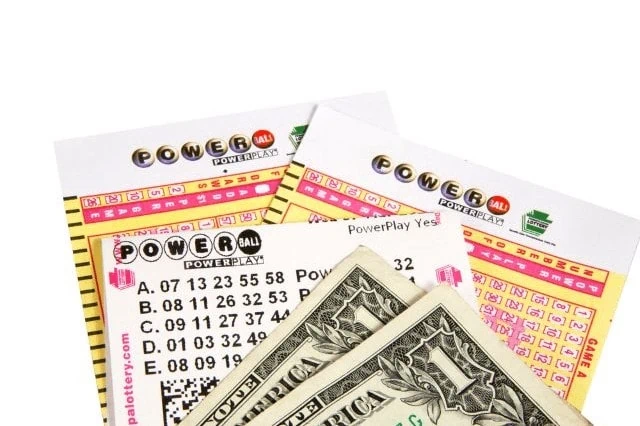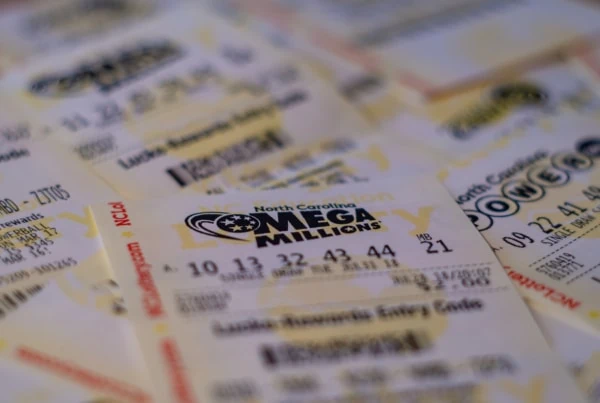The new year is certainly starting out right for one lucky person in Michigan who won Monday’s $842.4 million Powerball drawing. The odds of winning the jackpot are 1 in 292.2 million, but that didn’t stop the winner from picking all six numbers for the fifth largest prize in Powerball history.
The winner now has a decision to make—claim the $842.4 million in 30 annual annuity payments or take a one-time, lump-sum cash payment of approximately $425.2 million.
However, either way, the winner won’t have nearly that much to spend after taxes are taken out and paid. Uncle Sam is going to take a hefty share of the winnings to cover income taxes … and the winner’s state will take a chunk of it, too.
So, how much will the winner of the $842.4 million Powerball jackpot have to pay in taxes? And how much will be left over to spend? Read on to find out.
Federal Taxes on Powerball Winnings

Let’s start with some basics on how the federal government taxes Powerball winnings, which are considered taxable income.
Federal Tax Rates
First, you should know that the current federal income tax rates run from 10% to 37%. So, depending on the amount of prize money received, the federal tax on lottery winnings can be relatively low or quite high.
If we focus on large lottery prizes (like Monday’s $842.4 million Powerball jackpot), you can see how easily the highest federal tax rate comes into play. For the 2024 tax year, the top federal tax rate (37%) kicks in if your taxable income exceeds $609,350 and you’re single. If you’re married and file a joint tax return, then the top tax rate applies to taxable income over $731,200. As a result, lottery prizes above the applicable threshold amount will be taxed at the top federal tax rate.
Note, however, that most tax rates are scheduled to rise in 2026 (unless Congress steps in to keep them at the current rate). The top tax rate will jump to 39.6% at that time. This will impact lottery winners who receive payments over a 30-year period, because they’ll have to pay taxes on payments received after 2025 at the higher rate.
Tax Withholding
It’s also important to realize that, if you win a lottery prize of at least $5,000, 24% of your lottery winnings will be withheld from your payment for taxes and sent to the IRS. This will be applied toward your overall tax bill when you file your federal tax return for the year, so it’s not an additional tax. It’s more like paying part of the tax you’ll ultimately owe in advance.
For example, with a $1 million prize, $240,000 ($1 million x .24) would be subtracted from you payout immediately (i.e., you would only receive a $760,000 payment). However, when you file your tax return for the year, you would claim a credit for the amount withheld and $240,000 would be subtracted from your overall tax bill.
Form W-2G
If you win and collect at least $600 from a lottery in 2024, expect a Form W-2G in the mail by January 31, 2025. The form will list your lottery winnings, federal and state taxes withheld, and other information required by the IRS.
The IRS will also receive a copy of the form. So, make sure you report the proper amount when you file your tax return for any year you receive a lottery payment. If you don’t, the IRS will want to know why the amounts on the W-2G and your tax return don’t match … and you really don’t want to draw the IRS’s attention to your return.
Filing Your Tax Return
When it’s time to file your federal return, you’ll report any lottery winnings as gambling income on Line 8b of Schedule 1 (Form 1040). [The form or line number could change for 2024 tax returns.]
If you have gambling income, that means you can also deduct any gambling losses for the year … but only up to the amount of gambling income reported on your return. You also have to itemize to deduct gambling losses, which means you can’t claim the standard deduction on your return. As a result, depending on your standard deduction amount, you might be better off skipping the gambling loss deduction.
Federal and State Taxes On the $842.4 Million Powerball Jackpot (Jan. 1, 2024)

Now let’s focus on Monday’s Powerball drawing for an estimated $842.4 million jackpot. If you’re the lucky winner, approximately how much spending money would be left after taxes are paid to the federal government? Let’s do some math.
Lump-Sum Payout
Most lottery winners opt for a lump-sum amount. If the winner claims the lump-sum, he or she will pay approximately $157.3 million in federal taxes on the lump-sum prize of $425.2 million. About $102 million (24%) will be withheld from the payment up front, so the winner will have to pay the rest of the $157.3 million when he or she files a 2024 federal income tax return next year.
Assuming the winner lives in Michigan (that’s where the winning ticket was sold), another 4.25% in state taxes will be due. That comes to about $18.1 million in additional taxes (the full amount will be withheld from the lump-sum payment).
So, between federal and state taxes, the winner’s income tax bill will come to approximately $175.4 million. If $175.4 million is subtracted from the $425.2 million lump-sum payment, that leaves about $249.8 million to spend. While that doesn’t sound as nice as $842.4 million, it’s not too shabby for a $2 investment.
Annuity Option
If the winner selects the annuity option, he or she will receive an initial annuity payment when the prize is claimed, followed by 29 annual payments that increase by 5% each year (i.e., a total of 30 annual payments). Assuming the winner is single and receives the first payment in 2024 (approximately $12.7 million), the total federal income tax bill for the first two payments (2024 and 2025) will be based on the current 37% tax rate—for a total of about $9.5 million in tax for that period. (That assumes a 2.5% increase in the tax bracket thresholds from 2024 to 2025.)
Once the rate jumps to 39.6% in 2026 (and assuming it isn’t changed again later), the estimated total federal income tax for the final 28 years (2026 to 2053) comes to about $320.9 million. So, for all 30 years, the winner can expect to pay a grand total of about $330.4 million in federal income taxes.
Assuming the Michigan flat tax rate stays at 4.25% for the entire 30-year period, the winner will pay about $35.8 million in state income taxes on the jackpot payments.
That means the winner will pay a combined total of about $366.2 million in federal and state income taxes. When you subtract that amount from the $842.4 million in total payments, the winner will be left with approximately $476.2 million.
Which Payment Option Is Better?
After seeing the after-tax amounts above, you might be wondering why most people choose to receive their lottery winnings in a lump-sum. Afterall, isn’t getting $476.2 million better than $249.8 million?
Not necessarily. The problem with annuity payments is that you have to wait 30 years to get all your money. With the lump-sum option, you get less … but you get it right away. If you invest that money wisely over a 30-year period, you’ll probably end up with far more money in the bank when all is said and done. For example, after 30 years, a $249.8 million investment would turn into approximately $1.12 billion with a modest 5% rate of return (compounded monthly).
WealthUp Tip: All tax amounts are estimates based on the listed jackpot amounts. They should not be relied on or considered tax advice. If you do win the lottery, consult with a qualified tax professional right away!
Winning Numbers for Monday’s Powerball Drawing

The winning numbers for Monday’s drawing were white balls 12, 21, 42, 44, 49, and red Powerball 1. The Power Play was 3x.
Since there was a winner for Monday’s jackpot, the estimated grand prize for the next drawing (Wednesday, Jan. 3, 2024) is $20 million ($10.1 million with the lump-sum option).




![Child Tax Credit FAQs [What Every Parent Needs to Know] 8 child tax credit parents kissing baby](https://wealthup.com/wp-content/uploads/child-tax-credit-parents-kissing-baby-600x403.webp)


